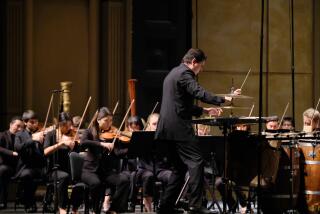A Loss of Support for the Arts : Fewer young Americans attend classical concerts, operas
- Share via
Although tastes have shifted from generation to generation, Americans have always been able to count on some measure of cultural common ground in the fine arts. But federal research shows that could be changing, and not for the better.
In 1982 and 1992, the National Endowment for the Arts conducted national surveys of adult American participation in so-called benchmark art forms--ballet, classical music, opera, musicals, plays, jazz and art museums. The poll, which divided individuals into seven birth cohorts, found that the greatest level of support came from the World War II generation, or those born between 1936-1945.
In sharp contrast, the report revealed that, on the whole, younger Americans, from a “baby boom dividing line” on down, appear to be showing waning interest for cultural fare. With the exception of jazz, ballet and trips to the museum, there were conspicuous declines in attendance among young people at concert halls and opera houses (see today’s Sunday Opinion Interview).
With all due respect to Pavarotti, it takes a special love and discipline to follow opera, supertitles not withstanding. Juggling jobs and children most definitely leaves less leisure time and less money for a night out, whether to the Met or the Music Center.
Here in Los Angeles, respected cultural institutions like the Los Angeles Philharmonic have stepped up their marketing efforts to the young by experimenting with cut-rate student prices and earlier starting times to accommodate working people with families. But these organizations are also fighting larger forces.
Cutbacks in music and art appreciation classes in the schools mean that fewer youngsters are being exposed to the Muses on a regular basis. At the same time, the arts are being squeezed by powerful trends in the larger marketplace. Sporting events, film, television, computers are all competing with the fine arts for dollars and time.
The trends show that it’s becoming harder for the arts community to draw nonparticipants into the cultural arena. But that doesn’t mean they can’t bring back audiences with an artist’s best weapon--creativity.
More to Read
The biggest entertainment stories
Get our big stories about Hollywood, film, television, music, arts, culture and more right in your inbox as soon as they publish.
You may occasionally receive promotional content from the Los Angeles Times.










